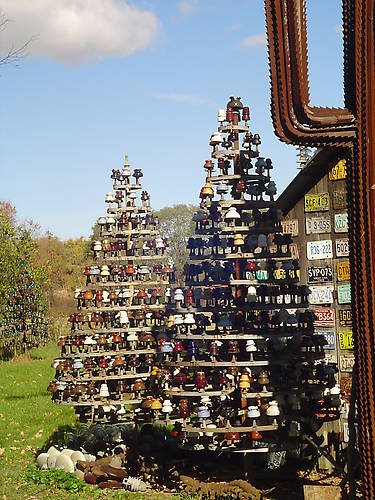Mud Madness 3
By James Mulvey; posted February 22, 2014
View Original: Click to zoom, then click to magnify (1536 x 2048) 1446KB

|
Mud Madness. Over the years a small mountain of porcelain insulators, both large and small, have found their way here. Some were donated, many were found and a few were purchased. Box after box of nothing special, many with chips but were keepers because they had colourful, bright, or wild glazes. Others were kept simply because what else can you do with, say, 300 white CPR beehives? [id=376582306;ugly porcelain display] To me every pin is a keeper, wood or metal it makes no difference. Those few that are different are set aside. The newer, common, galvanized pins are added to the 'pile'. Many years of scrounging has produced more than enough pins to create displays for hundreds of insulators. While there are still enough four pin tramp brackets on hand to make another tree or two, similar to the one I made last year for all the Ugly insulators, I try and make each display a little different. In addition to pins, innumerable metal crossarm braces were also in the pile. This display used unipart insulators, multiparts were used in this display [id=357847048] The braces are all a standard width of one inch but vary in length up to 30 inches . Installing them like spokes of a bicycle wheel, radiating out from the centre pole with several pins welded to each one, it quickly became evident that idea was not going to be acceptable. The tree needed to have more insulators and less spokes. A wheel of a different design was used where the braces were used to make a rim around the outside solved the problem. Using the existing holes these braces were simply bolted together using short carriage bolts. The top 'wheel' has a diameter of 10 inches. The next wheel placed seven inches lower, has a diameter increased by 5 inches, a pattern followed all the way down. Each circumference was calculated then adjusted slightly to allow an equal division for the pin spacing of 5.5 inches. To get the exact circumference one brace on each wheel needed to be cut to length and a hole drilled. The height of a tree is determined by the number of wheels. A three foot tree would hold a dozen insulators, a twenty foot tree could be more than a thousand. 600 pins were modified by shortening the shank to one inch - the same width as a brace. The pins were then welded at 5.5 inch intervals along the rim as well as along the six spokes used for each wheel. [id=397662674; close up of a wheel] After finishing this tree, I was amazed to find there was more than enough coloured porcelain on hand to fill it. A second tree was built to get all the porcelains out of storage. The result was two similar display trees with approximately 300 pins on each. One is for the coloured porcelain, the other is mostly all white, mainly beehives - a real 'B' hive. [id=397662817; frame without insulators] Both these displays used all recycled material so the cost was minimal. In addition they were simple to make. A similar tree could be made from new material. The cost would be more but it would be less work to construct. One inch flat stock for the rims and spokes, 1/2 inch bar stock would be suitable for the pins. A hacksaw and a welder would be the minimum equipment list. [id=390128942; 600 white insulators] |